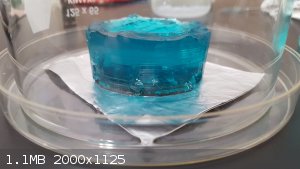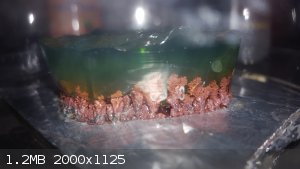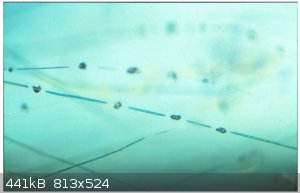| Pages:
1
2 |
elementcollector1
International Hazard
    
Posts: 2684
Registered: 28-12-2011
Location: The Known Universe
Member Is Offline
Mood: Molten
|
|
Concentrated solution doesn't seem to work for me - the gelatin is refusing to solidify upon being chilled. Not sure if I'm following the right recipe
- 50 mL cold liquid, add 1/4 oz. of Knox gelatin, add 50 mL of boiling water and stir until homogenous are the instructions I found.
Elements Collected:52/87
Latest Acquired: Cl
Next in Line: Nd
|
|
|
mayko
International Hazard
    
Posts: 1218
Registered: 17-1-2013
Location: Carrboro, NC
Member Is Offline
Mood: anomalous (Euclid class)
|
|
These are both probably factors, though I can't guess their relative importance. When I've seen copper displace out of low-viscosity solution, it's
generally been in bumpy sheets, which would make intuitive sense in a fast-diffusion regime, whereas diffusion-limiting conditions tend to cause
branching growths. There's another characteristic parameter, the sticking coefficient, which measures the rate at which new branches sprout; the gel
might change that, though it's not obvious how.
https://en.wikipedia.org/wiki/Diffusion-limited_aggregation
Quote: Originally posted by MrHomeScientist  | So you made your copper gel (mixing gelatin into concentrated copper sulfate solution?) and just laid it on top of aluminum foil? That's really
interesting; I wonder how it eats through the oxide layer? Normally you need chloride ions for that.
|
That's an interesting point; I put a few crystals of copper sulfate on a piece of foil with a bit of water and left it until it evaporated to confirm
that there was no corrosion. The package lists only gelatin in the ingredients and the nutritional information lists 0 mg sodium, so if there's any
salt it's in trace amounts.
| Quote: | | Have you tried any other metal solutions? |
Not yet!
Quote: Originally posted by elementcollector1  | | Concentrated solution doesn't seem to work for me - the gelatin is refusing to solidify upon being chilled. Not sure if I'm following the right recipe
- 50 mL cold liquid, add 1/4 oz. of Knox gelatin, add 50 mL of boiling water and stir until homogenous are the instructions I found.
|
I used half as much water as the recipe called for; the gel is firmer and easier to manipulate.
al-khemie is not a terrorist organization
"Chemicals, chemicals... I need chemicals!" - George Hayduke
"Wubbalubba dub-dub!" - Rick Sanchez
|
|
|
NEMO-Chemistry
International Hazard
    
Posts: 1559
Registered: 29-5-2016
Location: UK
Member Is Offline
Mood: No Mood
|
|
I am looking into Cobalt Iodate using a gel. the paper i am using is this one
Attachment: bjp2014_4_315-320.pdf (504kB)
This file has been downloaded 428 times
|
|
|
gatosgr
Hazard to Others
  
Posts: 237
Registered: 7-4-2015
Member Is Offline
Mood: No Mood
|
|
I have grown large urea crystals in glycerin, the molar ratio was 2:1 urea:glycerol or something.
|
|
|
MrHomeScientist
International Hazard
    
Posts: 1806
Registered: 24-10-2010
Location: Flerovium
Member Is Offline
Mood: No Mood
|
|
I got around to giving mayko's experiment a try, and I got a very nice copper sulfate gel that's currently sitting on some folded Al
foil to try to grow some Cu dendrites.
I pretty much followed the instructions on the gelatin packet: I started with 50mL copper sulfate solution of unknown concentration (it's old; I don't
remember!) and added 1 packet of Knox gelatin. To this I mixed in 40mL of boiling water, and stirred to dissolve. After letting it set in the fridge
for 3 hours I had a nicely formed beautiful light blue gel.
I extracted this from the beaker and cut the foam off the top to get a disc. I then folded up a piece of Al foil (about 4 layers) and set the gel on
top of it, covered with an evaporating dish so it didn't dehydrate.

After letting it sit for a day, there are tiny bits of copper growing up into the gel.

The copper developed pretty quickly in just a few hours, and has stayed the same all day. It has not yet eaten all the way through the foil, though.
Mayko, about how long did it take yours to form those nice, large dendrites?
I'll start up another one this weekend using a large brick of soda can aluminum I melted down a while ago and see if that does any better. Fun stuff!
|
|
|
MrHomeScientist
International Hazard
    
Posts: 1806
Registered: 24-10-2010
Location: Flerovium
Member Is Offline
Mood: No Mood
|
|
About 5 days on, the copper dendrites are growing nicely! The gel has also darkened and shrank somewhat; possibly due to ion infiltration and
dehydration, respectively. Still hasn't penetrated all the way through the foil though!

|
|
|
happyfooddance
National Hazard
   
Posts: 530
Registered: 9-11-2017
Location: Los Angeles, Ca.
Member Is Offline
Mood: No Mood
|
|
That is so cool! I can't wait to see how they develop... Pretty impressive for only five days of growth!
|
|
|
elementcollector1
International Hazard
    
Posts: 2684
Registered: 28-12-2011
Location: The Known Universe
Member Is Offline
Mood: Molten
|
|
Do you think they're solidly built, or brittle and prone to fracturing easily?
Elements Collected:52/87
Latest Acquired: Cl
Next in Line: Nd
|
|
|
MrHomeScientist
International Hazard
    
Posts: 1806
Registered: 24-10-2010
Location: Flerovium
Member Is Offline
Mood: No Mood
|
|
I guess we'll find out...
They look decent enough, but they are small and feathery so who knows. My plan was to dissolve the gel in hot water to free the dendrites, to
hopefully avoid any mechanical damage.
|
|
|
Bezaleel
Hazard to Others
  
Posts: 444
Registered: 28-2-2009
Member Is Offline
Mood: transitional
|
|
NEMO, did you obtain any results?
I read the paper you attached, but I am quite underwhelmed by their experimental method. Actually, I doubt whether they have made any good use of the
gel they created. The crystals they made all grew on top of the gel in their test tubes, where it seems (judging picture 1 in the article)
that merely the cobalt diffused into the potassium iodate solution on top of it, instead of the other way around.
It seems to me that the authors did not have any proper nucleation control, as explained of page 370 vv. in this review article. Thus they got many crystals grown together. I think that addition of a layer of neutral 'reaction gel' layer would have much
helped them.
Another article of interest can be found here.
|
|
|
MrHomeScientist
International Hazard
    
Posts: 1806
Registered: 24-10-2010
Location: Flerovium
Member Is Offline
Mood: No Mood
|
|
Here's a picture taken on the 7th, 11 days into the experiment. I used the flash, and you can really see the details on the dendrites.

And here's one from today, 18 days after starting.

It's interesting how the color of the gel has changed over time, from light blue to green to brown.
Today I decided to stop the experiment, and removed it from the Al foil and cut it into quarters. I placed one of these pieces in a beaker and poured
boiling water over top of it, to try to dissolve the gel and keep the copper crystals intact. Unfortunately, they all pretty much crumbled to powder.
 A few harder chunks stayed together, but they don't look crystalline at all. I
still have the other 3 sections if anyone has any other ideas on how to extract the crystals. A few harder chunks stayed together, but they don't look crystalline at all. I
still have the other 3 sections if anyone has any other ideas on how to extract the crystals.
It never made it all the way through the Al foil, but here's what it did to it.

|
|
|
NEMO-Chemistry
International Hazard
    
Posts: 1559
Registered: 29-5-2016
Location: UK
Member Is Offline
Mood: No Mood
|
|
The only thing I can think off is not what you want, removing any gel will remove support of the crystal and land you a mess, the only method i can
think of is to use another gel.
For example alginate, if you make it with a fair amount of starch its pretty firm, then once its formed the crystals you could soak in a chloride
solution. That would make a really hard outer, the trick would be to use just enough to cover crystals.
With enough playing you might get close to what you want, but i think the gel will always need to be in place. I have seen a method for water glass
crystal gardens, i cant remember a thing about it, except it was a way to remove the water glass solution and keep the garden structure of crystal.
So maybe a little research in that direction might help.
|
|
|
MrHomeScientist
International Hazard
    
Posts: 1806
Registered: 24-10-2010
Location: Flerovium
Member Is Offline
Mood: No Mood
|
|
This thing is a real pain in the ass to clean up, too. After dissolving the gel in water, I added baking soda to precipitate the copper. The solution
clouded up, but NOTHING settled out and it is now unfilterable. Several days of sitting shows a tiny bit settled to the bottom but I don't think it
will ever clear up completely. Not quite sure how to dispose of this.
|
|
|
NEMO-Chemistry
International Hazard
    
Posts: 1559
Registered: 29-5-2016
Location: UK
Member Is Offline
Mood: No Mood
|
|
You got a centrifuge? Or a pillar drill (same thing  ), that might settle it
into a pellet. ), that might settle it
into a pellet.
|
|
|
mayko
International Hazard
    
Posts: 1218
Registered: 17-1-2013
Location: Carrboro, NC
Member Is Offline
Mood: anomalous (Euclid class)
|
|
I tried to dissolve away the gel by keeping it submerged and changing the water daily. This seemed to remove the copper but didn't disrupt the gel
very much. I wondered if some sort of digestive enzyme (fresh pineapple juice?) could work, but a mold issue set in before I could test it.
al-khemie is not a terrorist organization
"Chemicals, chemicals... I need chemicals!" - George Hayduke
"Wubbalubba dub-dub!" - Rick Sanchez
|
|
|
DraconicAcid
International Hazard
    
Posts: 4356
Registered: 1-2-2013
Location: The tiniest college campus ever....
Member Is Offline
Mood: Semi-victorious.
|
|
Copper(II) aspirinate doesn't work for me in this method. The copper oxalate that I set up has changed completely to crystals of Na2[Cu(ox)2] (of
whatever hydration).
I did set up some tubes with a gel packed with ammonium (di)hydrogen phosphate as a buffer- it gelled within an hour. Layering this with various
salts seems to be giving lots of needly crystals of NH4MgPO4 and NH4NiPO4, but the copper and cobalt solutions have just given a solid skin of
precipitate between the two layers.
Details- 6 mL of 85% phosphoric acid was diluted with 20 mL of water. 9 mL conc. ammonia was carefully added, and the solution diluted to 60 mL.
5 mL of commercial water glass solution was diluted to 60 mL, then mixed vigorously with the first solution. This was poured into four portions in
large test tubes. After the solution had gelled, a layer of ~0.5 mol/L magnesium sulphate/copper(II) acetate/nickel sulphate/cobalt sulphate was
carefully layered on top.
Please remember: "Filtrate" is not a verb.
Write up your lab reports the way your instructor wants them, not the way your ex-instructor wants them.
|
|
|
DraconicAcid
International Hazard
    
Posts: 4356
Registered: 1-2-2013
Location: The tiniest college campus ever....
Member Is Offline
Mood: Semi-victorious.
|
|
This is the result of diffusing magnesium, nickel, and cobalt into gels of silica/ammonium phosphate.
NH4MgPO4 and NH4NiPO4 seem to give feathery crystals; the cobalt just gives a solid film between the layers.

I'll have to try it again with a much lower concentration of phosphate, or possibly just more acidic (the copper and cobalt may be giving a
precipitate of silicate rather than the desired ammonium metal phosphate).
[Edited on 20-3-2018 by DraconicAcid]
[Edited on 21-3-2018 by DraconicAcid]
Please remember: "Filtrate" is not a verb.
Write up your lab reports the way your instructor wants them, not the way your ex-instructor wants them.
|
|
|
mayko
International Hazard
    
Posts: 1218
Registered: 17-1-2013
Location: Carrboro, NC
Member Is Offline
Mood: anomalous (Euclid class)
|
|
Lead chemistry has never been interesting enough for me to make the toxicity worthwhile, but that might have just changed:
| Quote: | | This paper reports on an unusual crystal–crystal transformation phenomenon, which we have called the Morse Code Effect, based on the change in
appearance of lead(II) oxalate crystals grown in agarose gels. [...] the needle form crystals extended through the lower gel in an unusual manner,
showing apparent discontinuous growth. Needle growth appeared to be interrupted at intervals along the needle axes by small spaces containing one or
more poly- hedra which were not, however, joined to the needles. In some cases this gave rise to the ‘‘Morse Code” pattern: the dots are the
polyhedra, and the dashes the needles |

Lisgarten, J. N., & Marks, J. A. (2018). The Morse code effect: A crystal–crystal transformation observed in gel-grown lead (II) oxalate
crystals. Journal of Crystal Growth, 490, 35–40. http://doi.org/10.1016/j.jcrysgro.2018.01.004
Attachment: morseCodeCrystals.pdf (1.6MB)
This file has been downloaded 351 times
al-khemie is not a terrorist organization
"Chemicals, chemicals... I need chemicals!" - George Hayduke
"Wubbalubba dub-dub!" - Rick Sanchez
|
|
|
| Pages:
1
2 |